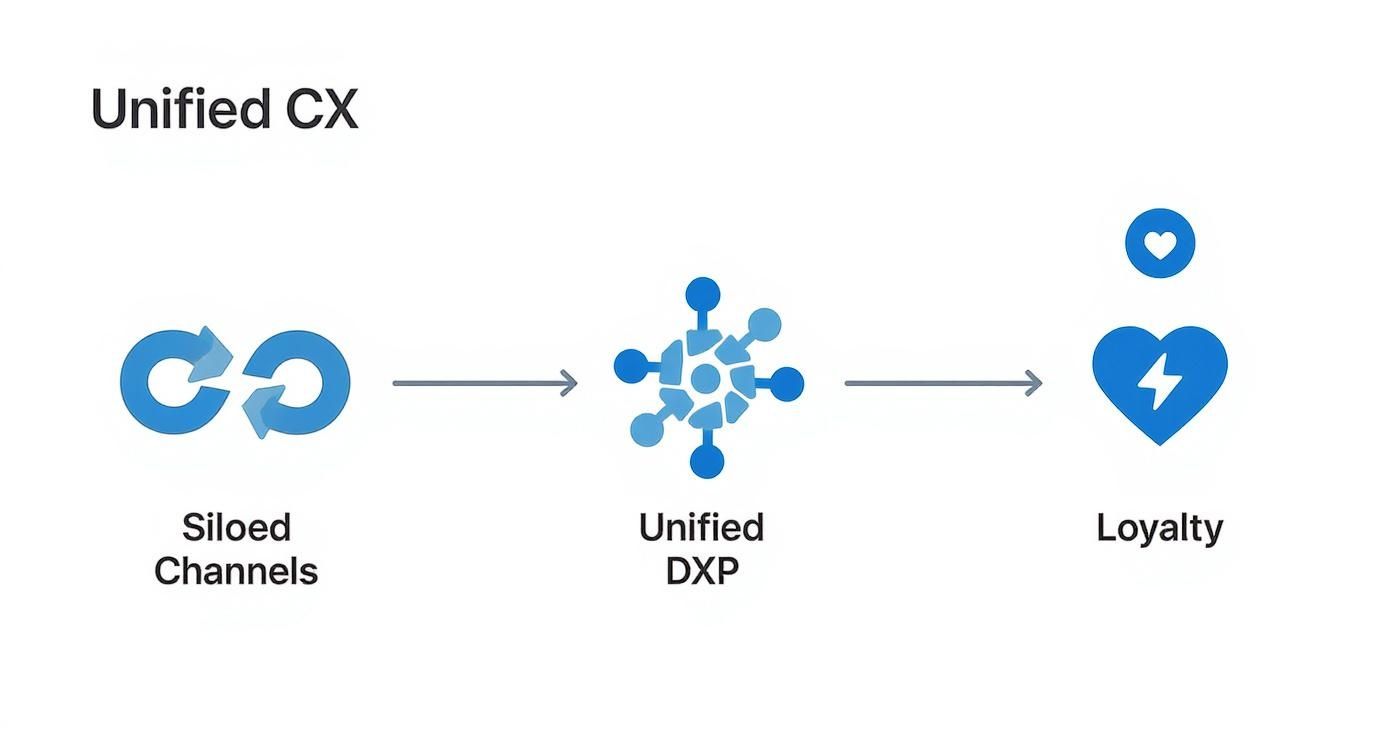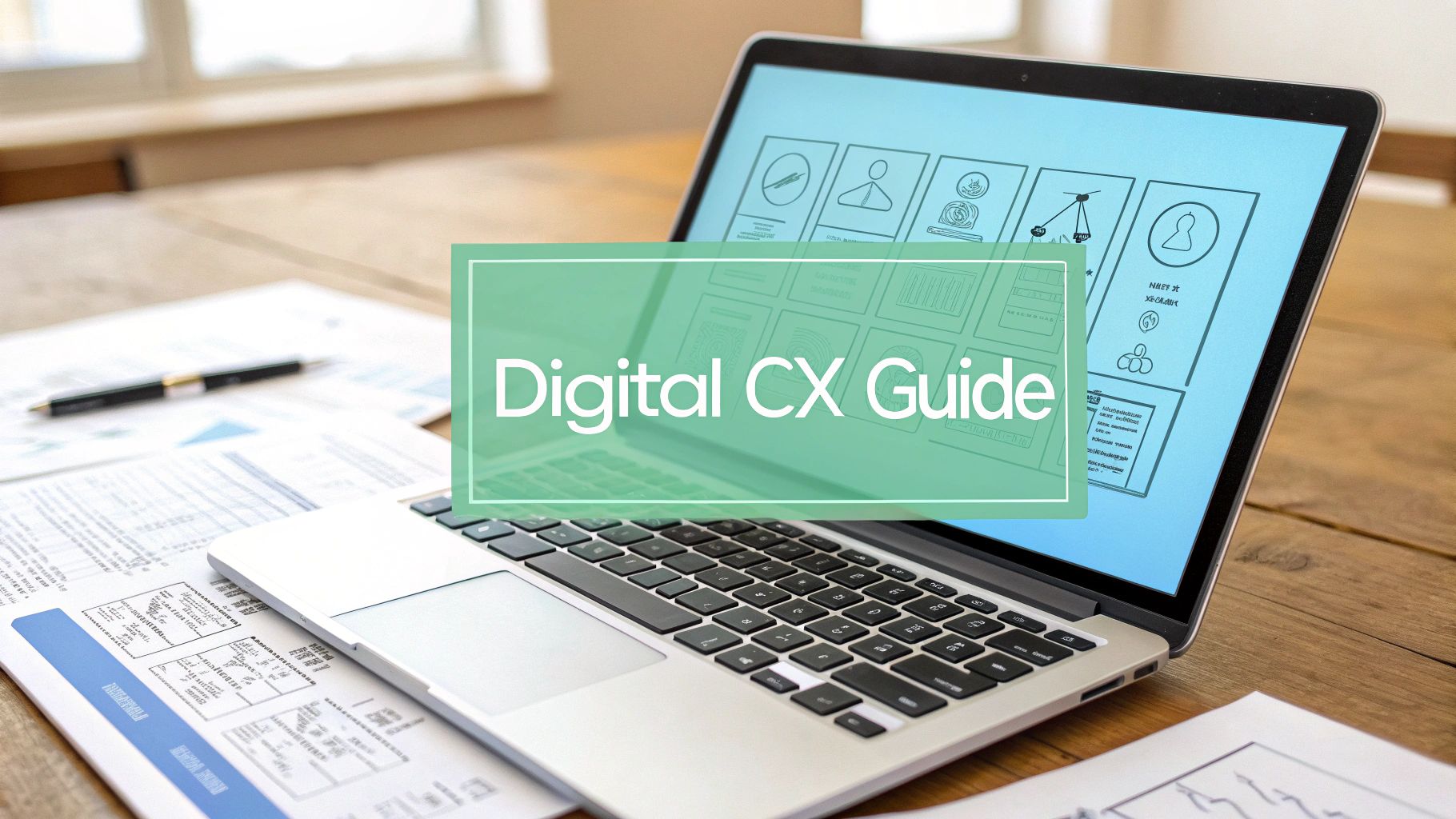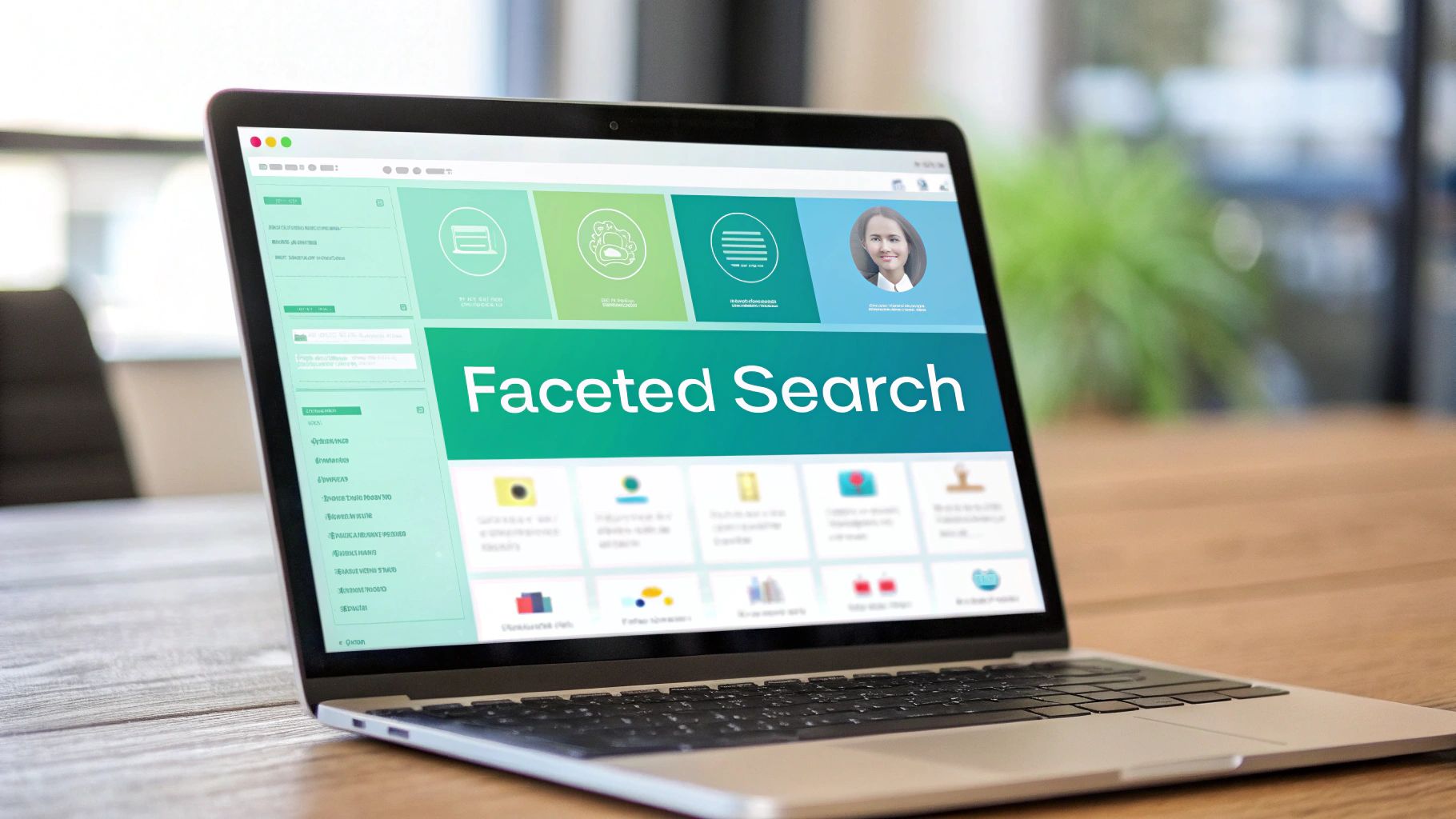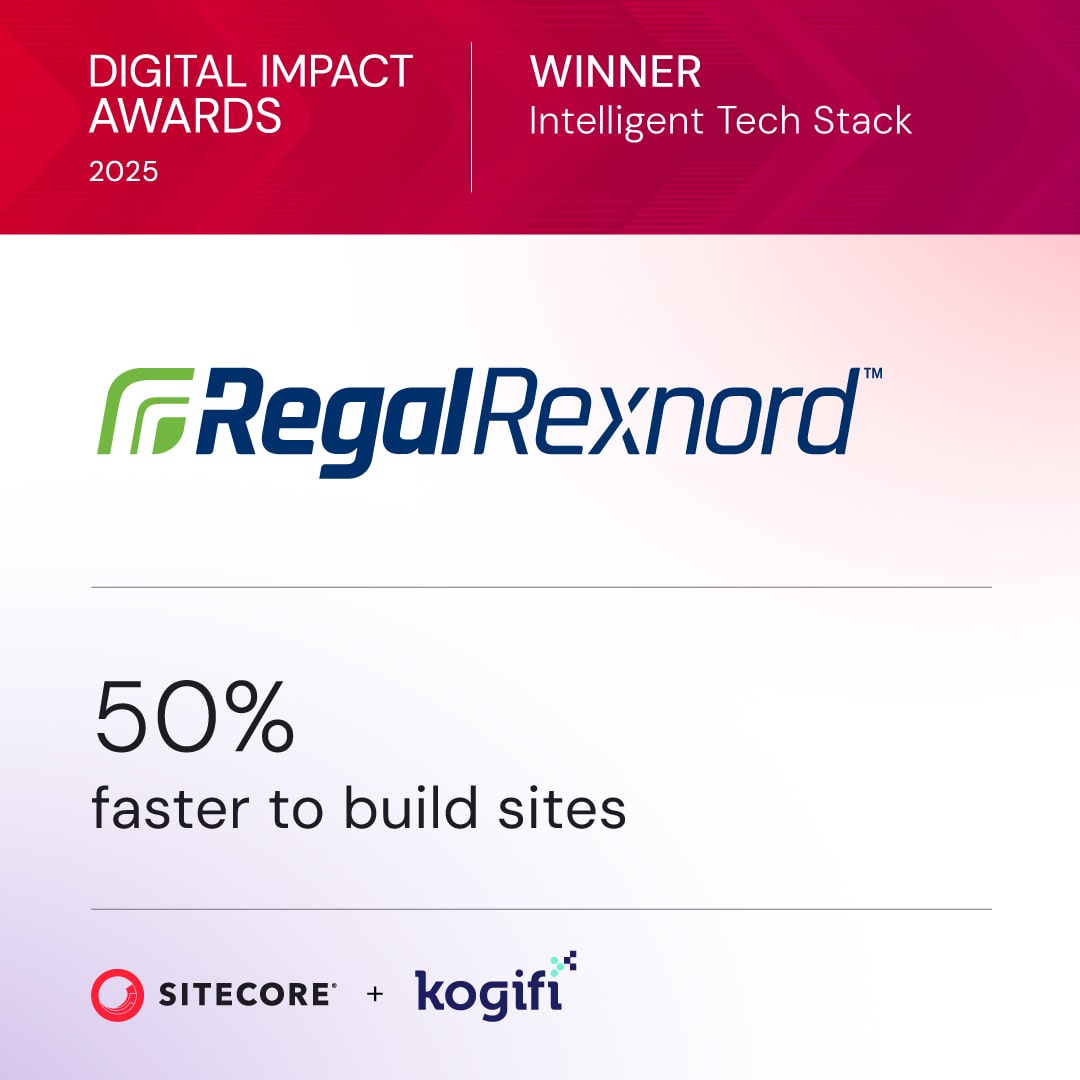Digital customer experience management is all about orchestrating every single digital touchpoint to build real, meaningful relationships. It goes way beyond just having a website. It’s about making sure every interaction—from the first social media ad a customer sees to a late-night support chat—feels seamless, engaging, and deeply personal.
Get this right, and you don’t just get customers; you create enthusiastic brand advocates.
Defining Digital Customer Experience Management

Think of your entire digital presence as a world-class theme park. A visitor might see an ad online, buy their ticket through your mobile app, pull up a map on your website, and later share photos on social media. Digital Customer Experience Management (DCXM) is the magic behind the scenes that makes sure this entire journey feels like one continuous, delightful adventure—not just a series of disconnected rides.
This isn't your old-school customer service. DCXM is a strategic approach that involves proactively designing, analyzing, and fine-tuning the entire customer lifecycle across all your digital channels. The goal is to build a unified ecosystem where every touchpoint remembers the last one, creating a consistent and personalized story for every single user.
Why It Is a Core Business Strategy
Let's be clear: DCXM is no longer a "nice-to-have." It’s a central growth engine for any modern business. Today's consumers don't just appreciate tailored experiences—they demand them. Companies that excel at personalization see their revenues grow significantly higher than their competitors.
To make all of this orchestration possible, a robust DCXM strategy needs a powerful engine. This is where a Digital Experience Platform (DXP) comes into play.
A DXP is the central hub that connects all your separate systems and data points to create a single, clear picture of the customer. It’s the tech that transforms a random collection of channels into a truly integrated experience.
A well-implemented DCXM strategy hinges on a few fundamental pillars that work together to create a cohesive and effective customer journey.
Core Pillars of Modern Digital CX Management
By focusing on these core areas, businesses can move from simply managing interactions to truly designing memorable and valuable digital experiences.
The Role of Technology Platforms
To execute a modern DCXM strategy, you need sophisticated tools, and platforms like Sitecore are engineered precisely for this purpose. Sitecore’s comprehensive portfolio gives businesses the power to map out complex customer journeys, analyze user behavior as it happens, and automate the delivery of personalized content at scale. It’s this level of capability that separates a basic website from a true digital experience hub.
Behind the scenes, a world-class external experience requires an equally efficient internal one. This is where solutions like SharePoint provide critical support. By streamlining internal workflows for content creation, collaboration, and asset management, SharePoint ensures that the content and data flowing into Sitecore are accurate, approved, and ready for delivery. This creates a solid foundation for delivering excellence on the outside.
Why a Unified Digital Experience Is a Strategic Imperative
Disconnected digital channels create friction. And friction costs you customers.
Think about it: a customer browses products on your mobile app and adds an item to their cart. Later, they switch to their laptop to complete the purchase, only to find the cart completely empty. This kind of siloed experience, where your digital touchpoints don't talk to each other, is a direct path to frustration and lost sales.
Each disjointed interaction introduces another crack in the customer relationship. When a user has to re-explain their problem to a support chatbot after already detailing it in an email, you’re not just wasting their time—you’re actively damaging their perception of your brand. These gaps aren't minor hiccups; they're significant business risks that erode trust and loyalty every single time they happen.
The High Cost of a Fractured Experience
The damage from a disconnected digital strategy is immense, both financially and reputationally. Today’s customer journey is anything but linear. People hop between channels constantly, and they expect the context of their interaction to follow them seamlessly.
The gap between how businesses think they’re doing and what customers actually feel can be staggering. A disconnected experience has a real, measurable economic impact, leading to lost revenue and customer churn. Poor customer service alone costs companies significant sums every year. Even worse, over half of all customers who have a negative experience will cut their spending with that brand. This proves a critical truth: a unified journey isn’t a luxury, it’s a core business necessity. You can find more insights on this crucial disconnect on Qualtrics.com.
A siloed experience forces the customer to do the hard work of connecting the dots for your business. A unified experience does that work for them, creating a journey that feels intuitive and effortless.
This is precisely where a composable Digital Experience Platform (DXP) comes in. Instead of wrestling with fragmented systems, a DXP acts as the central nervous system for your entire digital ecosystem.
Sitecore as the Central Nervous System
Platforms like Sitecore are engineered to solve this exact problem. A composable DXP from Sitecore provides the architectural backbone needed to unify all your separate systems, creating a single, dynamic view of each customer. It pulls this off by integrating data from all your critical platforms:
- Customer Relationship Management (CRM): Pulling in sales history, service interactions, and customer details.
- Enterprise Resource Planning (ERP): Accessing inventory levels, order information, and shipping status.
- Point of Sale (POS): Incorporating in-store purchase data into the digital profile.
- Marketing Automation Platforms: Tracking email engagement, campaign responses, and lead scores.
By connecting these sources, Sitecore’s Customer Data Platform (CDP) builds a rich, 360-degree customer profile in real-time. This profile becomes the foundation for genuine personalization and omnichannel consistency, allowing you to deliver experiences that are not only relevant but also contextually aware across every single touchpoint.
The Power of Integration for Internal and External Success
True integration isn't just about what the customer sees. For the experience to feel truly unified, your internal workflows must be just as seamless. This is where tools like SharePoint play a vital role, acting as a centralized content and collaboration hub for your marketing and support teams.
For example, a team can create and approve marketing assets within a SharePoint library, which then automatically sync with Sitecore’s content repository for publishing. This simple step eliminates version control nightmares and ensures the content customers see is always accurate and on-brand. The synergy between marketing automation and CRM integration is a powerful growth engine, essential for nurturing leads and delivering a truly unified experience.
Ultimately, a unified digital experience—powered by Sitecore and supported by SharePoint—protects your bottom line. It eliminates friction, builds lasting loyalty, and meets the incredibly high expectations of today’s digital-first customer.
Building Your DCXM Foundation on Sitecore's DXP
Putting theory into practice demands a powerful engine, and for a modern digital customer experience management strategy, that engine is often Sitecore's Digital Experience Platform (DXP). This isn't about shoehorning your business into a rigid, one-size-fits-all suite. Instead, Sitecore’s composable architecture gives you a massive strategic advantage: the freedom to assemble a best-in-class tech stack that’s a perfect match for your unique business needs.
This flexibility is what makes a resilient and future-proof DCXM strategy possible. You can plug in specialized tools for e-commerce, analytics, or marketing automation, making sure every single piece of your ecosystem is top-tier. It’s an approach that sidesteps vendor lock-in and lets you pivot quickly as customer expectations and market dynamics shift.
The infographic below really brings this to life, showing the evolution from disconnected, siloed channels to a unified DXP that builds genuine customer loyalty.

You can see how a DXP acts as the central hub, weaving fragmented interactions into a single, cohesive journey that creates lasting brand fans.
The Core Components of Sitecore's Composable DXP
At the heart of Sitecore’s DXP are a few interconnected products, each playing a critical role in orchestrating the customer journey. Getting a handle on how they work together is the first step to unlocking the platform's full potential. These components are intentionally modular, giving you the power to start with what you need and scale up as you grow.
This composable model allows organizations to build a truly custom solution for their digital customer experience management needs.
Here are the key players in the Sitecore ecosystem:
- Sitecore XM Cloud: Think of this as the cornerstone for all your content. It’s a cloud-native, headless CMS, which means it separates your content repository (the "body") from the presentation layer (the "head"). This gives developers total freedom to build front-end experiences with any modern tech they want—like React or Vue.js—while marketers keep full control over content creation in a familiar interface. That kind of agility is essential for pushing consistent content to websites, mobile apps, kiosks, and whatever digital touchpoint comes next.
- Sitecore Customer Data Platform (CDP): This is the brain of your customer intelligence operation. The CDP pulls in data from every imaginable source—website analytics, CRM history, app usage, in-store purchases—and stitches it all together into a single, persistent profile for each customer. This 360-degree view is updated in real-time, giving you the deep insights needed to understand customer behavior and intent on a truly granular level.
- Sitecore Personalize: Here’s where all that rich CDP data gets put to work. Sitecore Personalize is an AI-powered decisioning engine that delivers true one-to-one personalization in the moment. It uses advanced algorithms to figure out the perfect content, offer, or experience to show each visitor at any given time. From A/B testing to triggered experiences based on real-time behavior, this tool is what turns anonymous visitors into known, engaged customers.
An E-commerce Journey Powered by Sitecore
To see how these pieces click together, let's walk through a real-world e-commerce scenario. Imagine a new visitor, Sarah, lands on an online clothing store’s homepage after clicking a social media ad.
- Initial Contact (XM Cloud & CDP): The landing page she sees is served up instantly by XM Cloud. As she starts browsing, Sitecore CDP quietly begins building her profile, noting her clicks on women's running shoes and adding that info to her anonymous profile.
- Real-Time Engagement (Personalize): When Sarah returns to the homepage, Sitecore Personalize uses the fresh data from the CDP. Instead of a generic banner, she now sees a promotion for "New Arrivals in Women's Running Gear." The system recognized her interest and tailored the experience on the fly.
- Building the Profile (CDP): Sarah adds a pair of shoes to her cart but gets distracted. Before leaving, she signs up for the newsletter to get a discount code. The CDP immediately merges her anonymous browsing history with her new email address, creating a unified, known profile.
- Omnichannel Follow-Up (Personalize & CDP): The next day, an automated email is triggered reminding her about the shoes in her cart. When she opens the brand's mobile app later, the homepage prominently features those exact shoes and related accessories. The experience is perfectly consistent and context-aware across every channel.
This carefully orchestrated journey, driven by Sitecore's integrated tools, transforms a simple visit into a highly relevant and compelling experience. The platform doesn't just manage content; it actively shapes the customer journey based on real-time data, driving conversions and building loyalty. For more in-depth strategies, our complete guide to digital customer experience offers additional insights.
Streamlining Internal Workflows with SharePoint
You can’t deliver a world-class external digital experience if your internal one is a mess. It's that simple. When your teams are wrestling with clunky processes, hunting for scattered assets, and drowning in confusing email threads, that friction always finds its way to the customer. A truly effective digital customer experience management strategy has to master both the stage and the backstage.
Think of it this way: Sitecore commands the stage, delivering those slick, personalized experiences to your audience. But backstage? That’s Microsoft SharePoint’s territory. It’s the central hub where your marketing, content, and support teams actually get the work done. This internal harmony is the foundation for a consistent, high-quality external performance.
SharePoint brings order to the entire content lifecycle, from the first spark of an idea to the final published piece. It puts an end to the chaos of endless email chains and version-control nightmares, creating a single source of truth for every digital asset.
The Central Hub for Content and Collaboration
An efficient digital experience hinges on one thing: giving your teams instant access to the right information. SharePoint makes this happen by creating a unified workspace where collaboration is second nature. It’s far more than a digital filing cabinet; it’s an active environment where ideas are born, developed, and approved.
By weaving SharePoint into your digital customer experience management ecosystem, you can set up clear, automated workflows that keep projects from stalling. This structure guarantees that every piece of content is properly reviewed, approved, and on-brand long before a customer ever sees it. That internal discipline is what makes a high-quality external presence possible.
Key functions include:
- Digital Asset Management: A central library for every image, video, document, and brand guideline you own. Everyone uses the latest, approved versions—no more guesswork.
- Collaborative Campaign Planning: Shared calendars, task lists, and project sites let marketing teams coordinate even the most complex campaigns without dropping the ball.
- Centralized Knowledge Sharing: A searchable knowledge base where support teams can instantly find accurate product info and troubleshooting guides, leading to faster, more consistent customer service.
When your internal teams can collaborate effortlessly, they can focus their energy on creating value for the customer instead of fighting internal processes. A smooth internal workflow is a direct investment in your external customer experience.
A Practical Use Case: Sitecore and SharePoint Integration
Let's walk through a common workflow: creating and publishing a new blog post. Without an integrated system, this is usually a messy process involving multiple Word docs flying around in emails and clunky manual uploads. With SharePoint and Sitecore working in tandem, it’s a completely different story.
- Drafting in SharePoint: The writer creates the blog post directly in a SharePoint document library. This gives them version history, co-authoring tools, and access to a shared library of approved images and assets.
- Automated Approval Workflow: Once the draft is ready, the writer kicks off an approval workflow. SharePoint automatically notifies the editor, then the legal team, and finally the marketing manager for a final look. Everyone can add comments and edits directly within the single document.
- Seamless Publishing to Sitecore: After the final sign-off, the content is pushed seamlessly from SharePoint right into Sitecore's content repository. The integration ensures all text, images, and metadata transfer perfectly, ready to go live on the website with a single click.
This integrated approach gets rid of manual handoffs, slashes the risk of human error, and dramatically shrinks the time it takes to get new content to market. By optimizing these internal operations, you give your teams the bandwidth to consistently deliver the incredible digital experiences customers now demand.
To see how this platform can fortify your internal structure, you can find more information about comprehensive SharePoint solutions.
Measuring Success and Optimizing Your Strategy

Managing your digital customer experience isn't a "set it and forget it" project. It’s a living, breathing cycle of measuring, learning, and fine-tuning. To do it right, you have to build solid feedback loops that turn raw data into smart, actionable growth strategies. This means looking past simple vanity metrics like page views and zeroing in on the KPIs that actually show how customers feel and drive real business results.
The aim is to build a data-driven culture where every decision is backed by evidence. Instead of guessing what your customers want, you use precise analytics to understand their behavior, find the friction points in their journey, and systematically make it better. This is where the powerful analytics in platforms like Sitecore really shine, turning your abstract goals into concrete actions.
Key Metrics for DCXM Success
To see if your strategy is actually working, you need a balanced set of metrics that captures both customer feelings and business outcomes. Think of these KPIs as the vital signs for the health of your digital experience.
- Net Promoter Score (NPS): The classic "how likely are you to recommend us?" question. It’s a great high-level indicator of brand loyalty and overall health.
- Customer Satisfaction (CSAT): Usually measured right after a specific interaction, like a support chat or a purchase. CSAT gives you immediate feedback on how well you handled that single touchpoint.
- Customer Effort Score (CES): This metric asks, "How easy was it to get your issue resolved?" A low effort score is a huge predictor of loyalty, because nobody likes jumping through hoops.
Of course, feelings don't pay the bills. You also need to track the hard data that connects a good experience to your bottom line. Things like conversion rates at each stage of the funnel, average order value (AOV), and customer lifetime value (CLV) are crucial for proving that your DCXM efforts are paying off financially. Our article on how to measure ROI can help you connect these dots.
The following table breaks down how these key metrics tie directly to your business goals.
Table: Key DCXM Metrics and Their Business Impact
By tracking this mix of metrics, you get a complete picture—not just whether customers are happy, but how that happiness translates into a healthier business.
Leveraging Sitecore for Granular Insights
This is where a platform like Sitecore becomes your secret weapon. Its analytics tools are built to give you deep, granular insights that go way beyond surface-level data. You can track user behavior at every single step, seeing exactly where customers get stuck and where they fly through with ease. You can finally see which personalization rules are actually driving sales and which content paths are leading to a dead end.
This level of detail is everything when it comes to optimization. For example, Sitecore's A/B and multivariate testing features let you experiment with different headlines, images, or calls-to-action to see what truly connects with specific customer segments. You can form a hypothesis—like "Changing this button from blue to green will boost checkout completions"—and test it with real traffic, letting the data, not opinions, guide your design.
A data-driven culture treats every part of the customer journey as a testable hypothesis. Sitecore provides the laboratory to run these experiments, turning insights directly into improved experiences and higher revenue.
This constant loop of testing, learning, and adapting is the true hallmark of a mature digital customer experience management practice. It draws a straight line from CX improvements to tangible business results like more revenue and better customer retention.
Fostering a Culture of Continuous Improvement
But technology alone won’t get you there. Your organization has to fully embrace a mindset of continuous optimization. This means making data accessible and easy to understand for everyone, not just the analytics team. When marketing, sales, and support can all see the impact of their work on shared dashboards, they become active players in making the customer experience better.
It's clear that business leaders are prioritizing this, with many planning to increase their CX budgets with a focus on analytics that help them gather and act on customer feedback. Combining powerful tools within the Sitecore ecosystem with a culture that’s hungry for data allows you to build a formidable DCXM strategy that doesn't just meet customer expectations—it consistently drives real business growth.
Common Questions About DCXM Implementation
Stepping into the world of digital customer experience management always sparks a few critical questions. Leaders aren't just interested in the high-level strategy; they want to know how a powerful new tech stack will actually work on the ground. Let's tackle some of the most common questions we hear from organizations as we guide them through integrating platforms like Sitecore and SharePoint.
Our goal here is to give you straight, practical answers. Think of this as your field guide to turning a grand DCXM vision into a functional, high-performing reality.
How Does Sitecore's Composable DXP Differ From a Traditional All-in-One Suite?
This is probably the most important question because it cuts right to the core of modern digital strategy.
Think of a traditional, monolithic DXP as a pre-packaged toolkit from a single brand. It gets the job done, but you're stuck with their hammer and their screwdriver, even if a much better one is available from another company.
Sitecore's composable DXP, on the other hand, is like building a custom workshop. You start with a world-class foundation and then hand-pick the absolute best tool for every single job—whether that’s personalization, e-commerce, or analytics.
This approach gives you two massive advantages:
- Agility: You can swap components in and out as your business needs change or as new, superior technologies emerge. You’re never locked into a single vendor's ecosystem, so your tech stack can evolve right alongside your strategy.
- Performance: By choosing specialized microservices for each function, you get the best possible performance for every task. You avoid the "jack-of-all-trades, master-of-none" problem that can plague all-in-one suites.
With a composable DXP, you aren't just buying a platform; you are designing a flexible, future-proof digital ecosystem. It’s a strategic shift from being a technology renter to being a technology architect, giving you unparalleled control over your digital customer experience management capabilities.
What Is the Primary Role of a CDP in a DCXM Strategy?
While a lot of pieces have to work together in DCXM, Sitecore's Customer Data Platform (CDP) is the central nervous system of the entire operation. Its main job is to create a single, unified, and real-time view of every single customer.
Imagine trying to understand a person by looking at just one photo. That’s what it's like without a CDP—you're only seeing isolated interactions. The CDP’s job is to collect the entire photo album by pulling in data from every touchpoint:
- Website clicks and browsing behavior
- Mobile app usage patterns
- CRM data and service interaction history
- In-store purchases and offline event attendance
- Social media engagement
It then intelligently stitches all that information together into a rich, 360-degree profile. This isn't just a static database; it's a living record that updates in real time with every new interaction. This complete, dynamic view is the fuel that powers true personalization. It lets you move beyond broad segments and deliver one-to-one experiences based on a deep understanding of each customer's individual journey, preferences, and intent.
Where Does SharePoint Fit with a Powerful DXP like Sitecore?
This is a classic "better together" story. If Sitecore is the stage where the customer experience plays out, then SharePoint is the highly organized backstage that makes the whole show possible. The two platforms serve distinct but deeply complementary roles.
SharePoint is the internal engine for creating, collaborating on, and governing content. It's where your teams work together to produce, review, and approve the digital assets that customers will eventually see. It provides a structured environment for:
- Content Lifecycle Management: From the first draft to final approval, SharePoint workflows ensure every piece of content is vetted for accuracy, brand consistency, and compliance.
- Digital Asset Management (DAM): It acts as a single source of truth for all images, videos, and documents, putting an end to version control chaos.
- Knowledge Sharing: It powers the internal knowledge bases that give your support teams the accurate information they need to help customers effectively.
The magic happens when this polished, approved content is seamlessly pushed from SharePoint into Sitecore for publication. This division of labor is incredibly efficient. It lets your creative and marketing teams work in the collaborative environment they already know (SharePoint), while Sitecore does what it does best: delivering that content in a highly personalized, context-aware way across all your channels. This partnership ensures the beautiful experiences your customers see are built on a rock-solid foundation of internal order.
How Do We Start Measuring the ROI of Our DCXM Efforts?
Measuring the return on investment for DCXM means shifting your focus. Instead of tracking isolated, channel-specific metrics, you need to connect experience improvements directly to business outcomes. The key is to draw a clear line from the KPIs you can measure in Sitecore to the financial results that matter to your stakeholders.
A great way to start is by running targeted experiments with Sitecore Analytics. For example, identify a key conversion point on your website, like a "request a demo" form. Then, set up a personalization rule that shows a targeted testimonial only to visitors from a specific industry.
From there, you can build out a more comprehensive ROI model:
- Track Conversion Uplift: Use A/B testing to measure the direct lift in conversions from specific personalization rules. If a personalized banner increases sign-ups by 15%, you can assign a direct monetary value to that improvement.
- Monitor Customer Lifetime Value (CLV): Use the CDP to segment customers based on how they engage with personalized experiences. Over time, you can track whether these highly engaged segments have a higher CLV than those who get a generic experience.
- Measure Efficiency Gains: A lower Customer Effort Score (CES), driven by a more intuitive digital journey, often leads to fewer support calls and higher retention. This has a direct impact on your operational costs and long-term profitability.
By tying your experience metrics to these tangible business outcomes, you can build a powerful case that shows how investing in digital customer experience management isn't just a cost—it's a powerful driver of revenue and growth.
At Kogifi, we specialize in designing and implementing these sophisticated digital ecosystems. Our expertise in Sitecore and SharePoint allows us to build the powerful, integrated platforms you need to deliver exceptional customer experiences and achieve measurable business results. Let's build your digital future together.








































